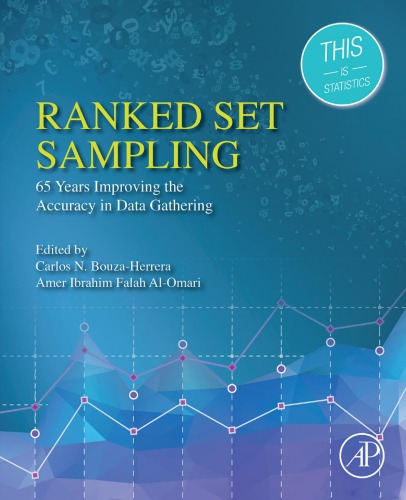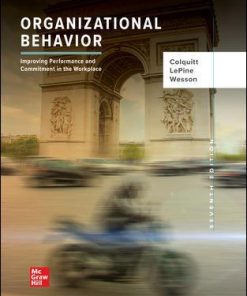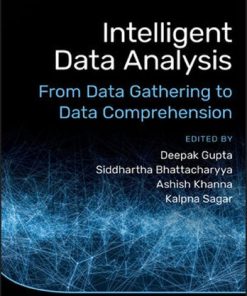(Ebook PDF) Ranked set sampling 65 years improving the accuracy in data gathering 1st edition by Carlos Bouza Herrera, Amer Ibrahim Falah Al Omari 0128156937 9780128156933 full chapters
$50.00 Original price was: $50.00.$25.00Current price is: $25.00.
Ranked set sampling: 65 years improving the accuracy in data gathering 1st edition by Carlos N. Bouza-Herrera, Amer Ibrahim Falah Al-Omari – Ebook PDF Instant Download/DeliveryISBN: 0128156937, 9780128156933
Full dowload Ranked set sampling: 65 years improving the accuracy in data gathering 1st edition after payment.

Product details:
ISBN-10 : 0128156937
ISBN-13 : 9780128156933
Author: Carlos N. Bouza-Herrera, Amer Ibrahim Falah Al-Omari
Ranked Set Sampling: 65 Years Improving the Accuracy in Data Gathering is an advanced survey technique which seeks to improve the likelihood that collected sample data presents a good representation of the population and minimizes the costs associated with obtaining them. The main focus of many agricultural, ecological and environmental studies is the development of well designed, cost-effective and efficient sampling designs, giving RSS techniques a particular place in resolving the disciplinary problems of economists in application contexts, particularly experimental economics. This book seeks to place RSS at the heart of economic study designs.
Ranked set sampling: 65 years improving the accuracy in data gathering 1st Table of contents:
1 Studying the Quality of Environment Variables Using a Randomized Response Procedure for the Estima
1.1 Introduction
1.2 Ranking Ordered Categorical Variables
1.3 A Randomized Response Strategy
1.4 Evaluation of the Performance of pcW
References
2 Development of a New Control Chart Based on Ranked Repetitive Sampling
2.1 Introduction
2.2 Shewhart Control Chart Under Repetitive Sampling
2.3 Ranked Set Sampling Scheme
2.3.1 Shewhart Control Charts Under the RSS Scheme
2.4 Shewhart Control Chart Under Ranked Repetitive Sampling
2.5 Performances of the Proposed Control Chart
2.5.1 Comparative Study: Monte Carlo Experiment 2
2.6 Concluding Remarks
References
3 Improved Ratio-Cum-Product Estimators of the Population Mean
3.1 Introduction
3.2 Sampling Methods
3.2.1 Ranked Set Sampling
3.2.2 Extreme Ranked Set Sampling
3.3 The Suggested Estimators
3.3.1 The First Suggested Estimator
3.3.2 The Second Suggested Estimator
3.3.3 The Third Suggested Estimator
3.4 Simulation Study
3.5 Conclusion
References
4 Estimation of the Distribution Function Using Moving Extreme Ranked Set Sampling (MERSS)
4.1 Introduction
4.1.1 Estimation of Distribution Function Using Method of Moments
4.1.2 Estimation of Distribution Function Using Maximum Likelihood Estimator
4.1.3 Fisher Information Number in MERSS about F(t)
4.2 MERSS Based on Minima
4.3 Estimation of F(x) Using Moving Extreme RSS Based on Minima and Maxima
4.3.1 MERSS Based on Both Minima and Maxima
4.4 Concluding Remarks and Suggested Future Work
Acknowledgments
References
Further Reading
5 Statistical Inference of Ranked Set Sampling Via Resampling Methods
5.1 Introduction
5.2 Statistical Inference for RSS
5.3 Bootstrap Method
5.4 Numerical Study
5.5 Conclusions
References
Further Reading
6 Extensions of Some Randomized Response Procedures Related with Gupta-Thornton Method: The Use of O
6.1 Introduction
6.2 The Considered Scrambling Procedures
6.3 Using Order Statistics (OS) for Scrambling
6.4 Conclusions
References
Further Reading
7 Ranked Set Sampling Estimation of the Population Mean When Information on an Attribute Is Availabl
7.1 Introduction
7.2 Ratio Type Estimators in SRSWR Using γ
7.3 Ratio Type Estimators in RSS Using γ
7.3.1 Some Basic Elements of RSS
7.3.2 Ratio Type Estimators
7.4 A Numerical Study of the Effect of a Vaccine for Lung Cancer
Acknowledgments
References
Further Reading
8 Modified Partially Ordered Judgment Subset Sampling Schemes
8.1 Introduction
8.2 Sampling Schemes
8.2.1 Ranked Set Sampling
8.2.2 Paired Ranked Set Sampling
8.2.3 L Ranked Set Sampling
8.2.4 Double-Ranked Set Sampling
8.2.5 Partially Ordered Judgment Subset Sampling
8.3 Proposed Sampling Schemes
8.3.1 Paired Partially Ordered Judgment Subset Sampling
8.3.2 L Partially Ordered Judgment Subset Sampling
8.3.3 Ranked Partially Ordered Judgment Subset Sampling
8.4 Efficiency Comparisons
8.5 An Example
8.6 Conclusions
Acknowledgments
References
9 Ranked Set Sampling With Unequal Sample Sizes
9.1 Introduction
9.2 Some Ranked Set Sampling Procedures
9.2.1 Ranked Set Sampling With Unequal Samples
9.2.2 Ranked Set Sampling With Unequal Samples and Unequal Replications
9.2.3 Ranked Set Sampling With Unequal Samples for Skew Distributions
9.3 Estimation of the Population Mean
9.4 Comparisons of Estimators
9.5 More Ranked Set Sampling Procedures with Unequal Samples
9.6 Applications to Real-World Data
References
10 A New Morgenstern Type Bivariate Exponential Distribution with Known Coefficient of Variation by
10.1 Introduction
10.2 Experimental Methods and Materials
10.2.1 Ranked Set Sample Mean as an Estimator of θ2
10.2.2 Best Linear Unbiased Estimator of θ2
10.2.3 Estimation of θ2 Based on Unbalanced Multistage Ranked Set Sampling
10.2.4 Estimation of θ2 Based on Unbalanced Single-Stage Ranked Set Sampling
10.2.5 Estimation of θ2 Based on Unbalanced Steady-State Ranked Set Sampling
10.3 Observations, Results, and Discussion
10.3.1 Relative Efficiency
10.4 Conclusion
Acknowledgments
References
11 Shrinkage Estimators of Scale Parameter Towards an Interval of Morgenstern Type Bivariate Uniform
11.1 Introduction
11.2 Review of RSS in FGM Family of Distribution
11.3 The Suggested Family of Estimators for the Scale Parameter θ2 Based on the a priori Interval
11.4 Relative Efficiency
11.5 Conclusion
Acknowledgments
References
12 Statistical Inference Using Stratified Ranked Set Samples From Finite Populations
12.1 Introduction
12.2 Stratified Ranked Set Sample
12.3 Statistical Inference
12.4 Estimators of Variance and MSPE
12.5 Empirical Results
12.6 Example
12.7 Concluding Remarks
Acknowledgment
References
Appendix
13 Simultaneous Estimation of Means of Two Sensitive Variables Using Ranked Set Sampling
13.1 Introduction
13.2 Ahmed, Sedory, and Singh Model
13.3 Proposed Ranked Set Sampling Randomized Response Model
13.4 Efficiency of Ranked Set Sampling
Acknowledgments
References
Appendix A
14 Forced Quantitative Randomized Response Model Using Ranked Set Sampling
14.1 Introduction
14.2 Proposed Forced Quantitative Randomized Response Model
14.3 Practicable Aspect of the Proposed FQRR Model
14.4 Relative Efficiency
14.5 Conclusions
Acknowledgments
References
Appendix A
15 Construction of Strata Boundaries for Ranked Set Sampling
15.1 Introduction
15.2 Stratified Random Sampling
15.3 Stratified Ranked Set Sampling
15.4 Numerical Illutrations
15.5 Conclusions
Acknowledgments
References
16 Calibrated Estimator of Population Mean Using Two-Stage Ranked Set Sampling
16.1 Introduction
16.2 Notations and Basic Results
16.3 Two-Stage Ranked Set Sampling
16.4 Calibrated Estimator in Two-Stage Ranked Set Sampling
16.5 Numerical Illustration With Real Data
Acknowledgments
References
Appendix A
17 Estimation of Population Mean Using Information on Auxiliary Attribute: A Review
17.1 Introduction
17.2 Estimation of Population Mean Using Single Auxiliary Attribute Information
17.3 Estimation of Population Mean Using Two (or More) Auxiliary Attribute Information
17.4 Conclusion
Acknowledgment
References
18 Ratio and Product Type Exponential Estimators for Population Mean Using Ranked Set Sampling
18.1 Introduction
18.2 Some Existing Estimators for the Population Mean
18.3 Proposed Estimators for Population Mean
18.3.1 Generalized Exponential Estimators Using RSS
18.4 A Simulation Study
18.5 Conclusions
References
19 Extropy Estimation in Ranked Set Sampling With its Application in Testing Uniformity
19.1 Introduction
19.2 Extropy Estimation Using a Ranked Set Sample
19.3 Extropy-Based Tests of Uniformity in RSS
References
Further Reading
20 Selection and Estimation in Ranked Set Sampling using R
20.1 Introduction
20.2 Notation and Basic Definitions
20.3 Using R for Ranked Set Sampling
20.3.1 Balanced Ranked Set Sampling
R Code
Usage
Arguments
Value
Function Code
20.3.2 Unbalanced Ranked Set Sampling
20.3.2.1 Case 1
R Code
Usage
Arguments
Value
Function Code
20.3.2.2 Case 2
R Code
Usage
Arguments
Value
Function Code
20.3.3 The Median Ranked Set Sampling Method
R Code
Usage
Arguments
Value
Function Code
20.4 Estimation Using RSS
20.5 Examples
20.5.1 Ranking with an inexpensive quantitative measurement
20.5.2 Ranking with a professional judgment
20.6 Additional Software
Acknowledgments
References
Further Reading
21 Variance Estimation of Persons Infected With AIDS Under Ranked Set Sampling
21.1 Introduction
21.2 Estimation of the Treatment Effects in a One-Way Layout in Ranked Set Sampling
21.3 Estimation of the Variance in RSS
21.4 Monte Carlo Evaluation
21.4.1 Normality-Based Tests
21.4.2 Analysis of the Time to Death of HIV-Infected Persons
21.5 Conclusions
People also search for Ranked set sampling: 65 years improving the accuracy in data gathering 1st:
ranked set sampling example
ranked set sampling ppt
ranked set sampling in r
ranked set sampling theory and applications
what is a good sampling percentage
You may also like…
Uncategorized
Medicine
Education Studies & Teaching
Uncategorized
Uncategorized












